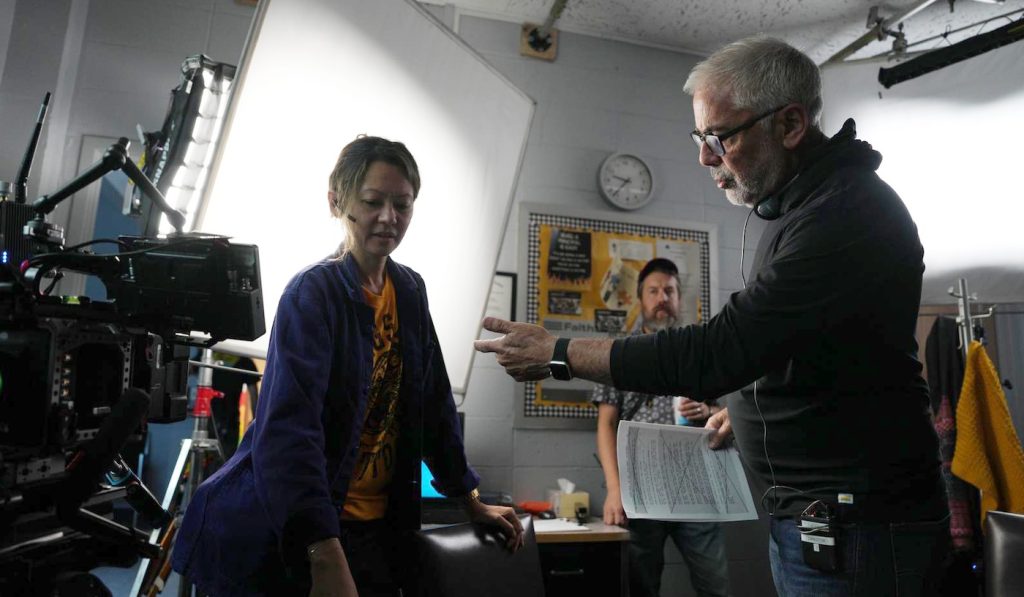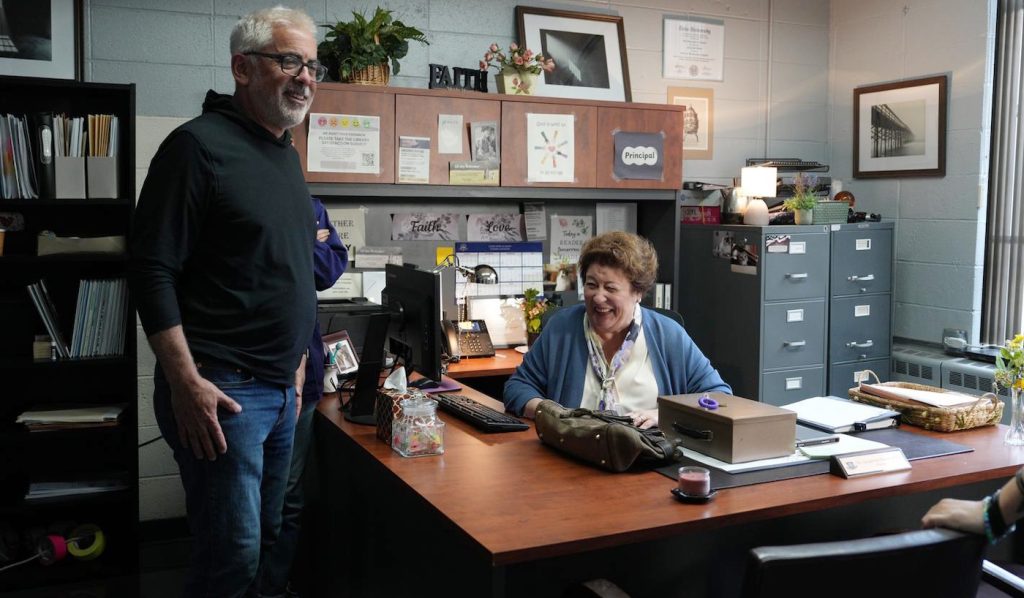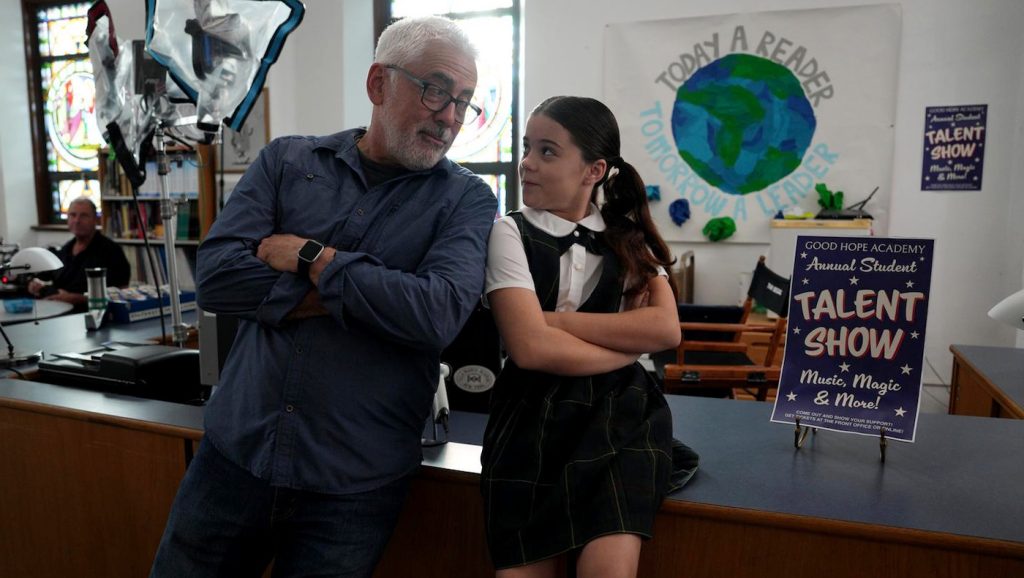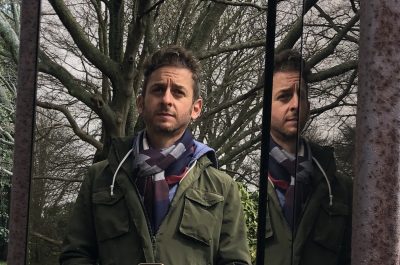Playing a Flush Hand: Inside “Poker Face” Season 2 With Producer/Director Adam Arkin
Few people in Hollywood have had as rich and varied a career as Adam Arkin. With decades of experience both in front of and behind the camera—from his breakthrough role in Northern Exposure to acclaimed directing work on series like The Americans, Justified, Sons of Anarchy, Fargo, Succession, and The Night Agent—Arkin brings decades of experience both in front and behind the camera to every project he tackles.
His latest endeavor finds him serving as producer and director on Rian Johnson’s Poker Face, the Peacock mystery series that has lovingly and hilariously updated the whodunit format for modern audiences. Starring Natasha Lyonne as Charlie Cale, a human bullsh*t detector who solves a crime per episode, the show follows her cross-country journey in a Plymouth Barracuda as she encounters murder and mayhem across small-town America, lending her gimlet eye and gift/curse to cases along the way. While Lyonne is one of the most delightful and singular performers on TV today, what rounds out Poker Face‘s flush hand is its incredible rotating ensemble cast—featuring everyone from Steve Buscemi and Benjamin Bratt to Rhea Perlman, Adrien Brody, Ron Perlman, Ellen Barkin, Tim Blake Nelson, and Chloë Sevigny—each bringing their talents to Johnson’s clever “howcatchem” format. For season two, Cynthia Erivo plays sextuplets.
For Arkin, who directed episodes 206 (“Sloppy Joseph”) and 207 (“One Last Job”) in the show’s second season, Poker Face presented unique challenges that stretched his considerable skills as both producer and director. In our conversation, he opened up about working with legendary guest stars, the logistical complexities of the show’s anthology-style format, and what draws him to quality projects after decades in the business.
I imagine Poker Face is a particularly fun show to work on, but not that easy to produce or direct, given the number of moving parts?
The approach to directing a mystery wasn’t that foreign to me. The dramatic elements of making sure you’re honoring those story points and creating clarity for the audience as to what’s going on, what the stakes are, are not difficult in and of themselves. What was one of the more challenging aspects of this show is that unlike almost any other series, every episode is so much of a standalone that it’s almost akin to having to do a pilot every time, because you’re working with new sets, new locations, and new cast members who are getting up to speed and checking both with themselves and with the producers that they’re in the zone—especially because of the echelon of guest stars that we had. You’re not working with people generally who’ve auditioned for things; a lot of it was done on an offer basis.
You do have an embarrassment of riches, I suppose.
I know from having been in the position of having things just offered, it’s simultaneously a great honor, but it’s also intimidating because you’re preparing and showing up on set your first day, and there’s a little thought in the back of my mind going, “What if when I start doing this and it’s not what anybody wanted or pictured?” At least with auditions, you know that you’ve done your interpretation of the role, and that’s what people have signed on for. There is also the aspect of the show having to reinvent itself every episode, as each episode was a standalone new event. I think that was probably the most challenging thing, not just for me, but for the entire company, because it’s just that much more work and creative commitment.

So, how do you get people to feel like, “Hey, look, you’re here for a reason. This is all going to work out”?
You just summed up what I feel like my approach is. To the extent that I was dealing with cast members coming in, in episodes that I was not directing, as a producerial presence, I just made it clear that the company was thrilled that they were there, that they were the number one choice for what everyone envisioned, and that we were there to be as supportive and welcoming to them in that effort as we could be. I know from my acting experience that being reminded that people want you there goes a long way towards allowing you to relax enough to do your best work. So I felt that was sort of the mandate with people coming in.
Let me ask you about filming location. Season two was shot in Brooklyn?
Yes. The sound stages were up in Greenpoint, Brooklyn and a lot of the locations that they used were in concentric circles radiating out from that area.
What is that like from a producer and director standpoint, where you don’t have the luxury of just being in the same location episode after episode?
You don’t even have any standing sets to return to. Even on shows that have a great deal of variety in terms of locations, you have the comfort zone of knowing that after they go and solve this crime, they’re going to be coming back to headquarters or their apartment. You had none of that on Poker Face—Charlie’s on the road. She changes locations and states, moving from urban to rural environments. So every episode required a level of commitment to location scouting and the time that goes into that, because especially on a show where our sound stages were in Brooklyn and yet we had locations that had to feel very rural—in one case, like the swamps of Florida—you’re not going to find that without getting in a van and logging in the miles to find the right location. There was just a lot of extra time and work that had to go into being on the road and finding places 95% of the time that were close enough to New York that we did not have to be housing people out of town, and yet still were convincing enough to be viable as our shooting locations.

When you were not on your sound stages, were you predominantly working in the five boroughs?
We worked a lot in the five boroughs. We shot in Manhattan, Queens, Staten Island, and Brooklyn. We shot a little bit in New Jersey, and then we shot in the upper Hudson Valley as well, on both sides of the river.
Can you walk me through your episodes? Episodes 206 and 207—”Sloppy Joseph” and “One Last Job”—especially working with Margo Martindale?
It was great. I really had a great time on both episodes. Both are very different, but equally satisfying. “Sloppy Joseph” was the first one I did—in spite of it being episode six, we shot it as the third episode of the season. I advocated for Margo and brought her up pretty early on. She was already on their radar as someone who would be a great Dr. Ham in that episode, and I was thrilled to get to work with her again. Poker Face was either the fifth or sixth show that I’ve worked with Margo on, going back to The Riches, Justified, The Americans, Sneaky Pete, now Poker Face. She goes back even further with my family because she worked with my father on the Sidney Lumet series 100 Centre Street back in the day. So it’s just an ongoing love affair with her. I think she’s also just screen gold. You put a camera on her, and you’re going to have something memorable happen.

How’d you approach “Sloppy Joseph”?
The script had a baked-in stylistic requirement of delineating between the children’s world and the adult world, which lent itself to some really fun visual approaches. I had the opportunity to work with a great DP who came on board only for that episode—this brilliant DP, Tari Segal—and we developed an approach to create the different worlds of adult and child. Then I was lucky enough to work with two extraordinarily talented kids—Eva Halford and Callum Vincent—who possess a level of professionalism and a clear understanding of why they want to be doing this that extends far beyond their chronological age. They both had very specific ideas. They were capable of taking sometimes complex notes and also doing technically demanding things.

There was one sequence with Eva where she had to ride a playground merry-go-round. Those kinds of sequences can be really challenging and time-consuming if people are not adept at remembering the continuity of what they’re doing. And she just had an uncanny knack of knowing how to match her actions and make sure she was saying her lines at the same point of the rotation of that toy, which seems like a small thing, but it made all the difference between us being able to get that sequence and not.
You also worked with David Krumholtz, who is one of those performers who sneakily steals scenes in every show or movie he’s in.
David is a wonderful actor and a lovely guy. The advantage of having him, in addition to all of that, was that he had a history with Natasha of having worked with her back on Slums of Beverly Hills, which, ironically, my father was also in. There was a kind of family reunion vibe to much of the episode, particularly between Margo and David, as well as Natasha’s history with David.
You’ve shot so many awesome series—The Night Agent, Succession, Fargo, and The Americans. What is your approach to selecting projects?
That’s a good question. I wish I could say it was always the quality of the writing or the relevance of the subject matter. When everything is going well, those are the most prominent criteria for making choices. But to be totally honest, sometimes it’s just a question of what’s going on and how long it’s been since I’ve worked, and is it time to get busy again? I’ve been fortunate to have had the opportunity to work on some excellent projects. And in some cases, having those be return engagements where there’s been an ongoing, multi-year, multi-season relationship—Justified, Sons of Anarchy, now The Night Agent being among those.
I guess you can’t really know, unless you’re coming into a series that’s already a hit, whether what you’re working on will resonate.
The shows that you’re listing are the ones that stayed in our consciousness, because they were good. I’ve done plenty of work that has come and gone and isn’t necessarily among the things people are referencing. I’ve done enough of this now to know that I’ve been involved with several situations where all of my standards, best instincts, research, and the questions I’ve asked ahead of time have been applied, and it’s looked like a can’t-lose situation. And then the process of doing it reveals impediments or dysfunction, or it just doesn’t turn out the way all that due diligence seemed to indicate. And I’ve had just the opposite experience where I thought I was doing something because it was time to do a money job and it’s not going to be great art, but hopefully I’ll have some fun—and had that turn out to be sometimes the end result being stuff that I’m incredibly proud of.
Featured image: POKER FACE — “TBD” Episode 206 — Pictured: (l-r) — (Photo by: Sarah Shatz/PEACOCK)



